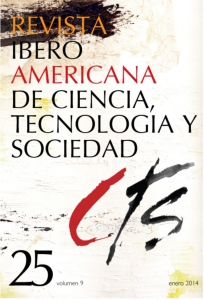The interaction between research and policy
conceptual approaches
DOI:
https://doi.org/10.52712/issn.1850-0013-621Keywords:
STI policies, STI research, knowledge transferAbstract
For several decades the field of social science has indicated that the knowledge generated as a result of the academic research can be a relevant input for the formulation of public policies. However, there is a broad consensus about the weakness of the exchanges between researchers and policy makers. In Argentina, a number of studies in the field of political science technology and innovation (STI) indicate that the transfer of academic knowledge to STI policy is not only rare but also a complex and not that automatic of a process. Under this framework, the objective of this article is the analysis and systematization of theoretical contributions that discuss about the complexity of the interaction between the fields of science and public policy, common issues in such processes as well as the factors that promote the influence of research in the production and design of public policies. As a result, this paper identifies several factors that could improve the understanding of knowledge transfer process.
Downloads
References
AMARA, N.; OUIMET, M. y LANDRY, R. (2004): “New Evidence on Instrumental, Conceptual, and Symbolic Utilization of University Research in Government Agencies”, Science Communication, Vol. 26, No. 1, pp. 75-106.
ANLLÓ, G.; LUGONES, G. y PEIRANO, F. (2008): “La innovación en la Argentina post-devaluación. Antecedentes previos y tendencias a futuro”, en B. Kosacoff (coord.): Crisis, recuperación y nuevos dilemas La economía argentina 2002-2007, Santiago de Chile, CEPAL, pp. 261-306.
ANLLÓ, G.; SUÁREZ, D. y DE ANGELIS, J. (2009): “Consulta a Tomadores de Decisión en Políticas Públicas de Ciencia, Tecnología e Innovación sobre sus fuentes de información”, Informe Argentina, Proyecto BID - IDB-TN-154.
ARZA, V. (2012): “Research organizations and policy making in Lain America”, Background Paper del Workshop “What kind of development research centers Latin America needs?”, organizado por REDMERCOSUR y IDRC-CRDI, Iguazú, 18 de noviembre de 2012, Argentina.
BAPTISTA, B.; BERNHEIM, R.; GARCÉ, A.y HERNÁNDEZ, E. (2010): “Consulta a Tomadores de Decisión en Políticas Públicas de Ciencia, Tecnología e Innovación sobre sus fuentes de información”, Informe Regional, Proyecto BID - IDB-TN-154.
BEYER, J. M. (1997): “Research utilization: Bridging the gap between communities”. Journal of Management Inquiry, n°6 (1), pp. 17-22.
CARDEN, F. (2009): “Knowledge to policy. Making the most of development research”, New Delhi, IDRC & Sage Publications.
CHUDNOWSKY, D. (1999): “Ciencia, tecnología y el sistema nacional de innovación”. Revista de la CEPAL, n° 67, pp. 157-175.
CREWE, E. y YOUNG, J. (2002): “Bridging Research and Policy: Context, Evidence and Links”, Working Paper 173, London, Overseas Development Institute.
ESTEBANEZ, M.E. (2004): “Conocimiento científico y políticas públicas: un análisis de la utilidad social de las investigaciones científicas en el campo social”. Espacio Abierto Cuaderno Venezolano de Sociología, Vol. 13, No. 1, pp. 7 – 37.
ESTEBANEZ, M.E. (2007): “Ciencia, Tecnología y Políticas Sociales”, Ciencia, Docencia y Tecnología - UNER, Paraná, Nro 34, AÑO XVII -ISSN 0327-5566
HUBERMAN, M. (1990): “Linkage between Researchers and Practitioners: A Qualitative Study”, American Educational Research Journal, Vol. 27, No. 2, pp. 363- 391.
LANDRY, R.; AMARA, N. & LAMARI, M. (2001): “Utilization of social science research knowledge in Canada”, Research Policy, Vol. 30, pp. 333–349.
LANDRY, R.; LAMARI, M. y AMARA, N. (2003): “The Extent and Determinants of the Utilization of University Research in Government Agencies”, Public Administration Review, Vol. 63, No. 2, pp. 192-205.
LUGONES, G.; PEIRANO, F. y GUTTI, P. (2005): “Potencialidades y limitaciones de los procesos de innovación en Argentina”, Disponible en: http://www3.centroredes.org.ar/files/documentos/Doc.Nro26.pdf. Consultado el 17 de enero de 2013.
LUGONES, G.; PORTA, F.; FERNÁNDEZ BUGNA, C.; MOLDOVÁN, P.; SUAREZ, D.y VISMARA, F.,(2008): “Retos y oportunidades del sistema argentino de ciencia, tecnología e innovación”. Documento de Consultoría elaborado para la División de Ciencia y Tecnología del Banco Interamericano de Desarrollo – Proyecto BID - A0004046 / 519331 / 0002.
MOST- UNESCO (2007): “Desarrollo social: de la investigación a la política y a la acción”. Disponible en: http://www.unesco.org/new/fileadmin/MULTIMEDIA/HQ/SHS /pdf/draft_concept_paper_es.pdf. Consultado el 5 de abril de 2013.
STONE, D.; MAXWELL, S. y KEATING, M. (2001): “Bridging Research and Policy”. Disponible en: http://depot.gdnet.org/gdnshare/pdf/Bridging.pdf. Consultado el 20 de abril de 2013.
STUBRIN, L. y KABABE, Y. (2013) “Mecanismos que facilitan el diálogo entre la investigación y la política pública de CTI en Argentina”. Ponencia en las Jornadas de Sociología de la Facultad de Ciencias Políticas y Sociales de la U.N.Cuyo. Mendoza, 9 y 10 de mayo de 2013.
WEISS, C. (1992): “Helping Government Think: Functions and Consequences of Policy Analysis Organizations”, California, Sage Publications.
WEISS, C. (1979): “The many meanings of research utilization”. Public Administration Review, Vol. 39, No. 5, pp. 426-431.
WISEMAN, J. (2010): “Dancing with strangers: Understanding the parallel universes of academic researchers and public sector policy makers”. Disponible en: http://www.anzsog.edu.au/media/upload/publication/25_occpaper_11_wiseman.pdf. Consultado el 4 de mayo de 2013.
Downloads
Published
How to Cite
Issue
Section
License
Copyright (c) 2024 CC Attribution 4.0

This work is licensed under a Creative Commons Attribution 4.0 International License.
All CTS's issues and academic articles are under a CC-BY license.
Since 2007, CTS has provided open and free access to all its contents, including the complete archive of its quarterly edition and the different products presented in its electronic platform. This decision is based on the belief that offering free access to published materials helps to build a greater and better exchange of knowledge.
In turn, for the quarterly edition, CTS allows institutional and thematic repositories, as well as personal web pages, to self-archive articles in their post-print or editorial version, immediately after the publication of the final version of each issue and under the condition that a link to the original source will be incorporated into the self-archive.











